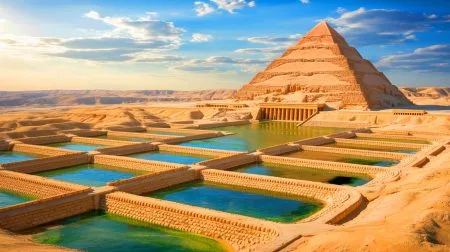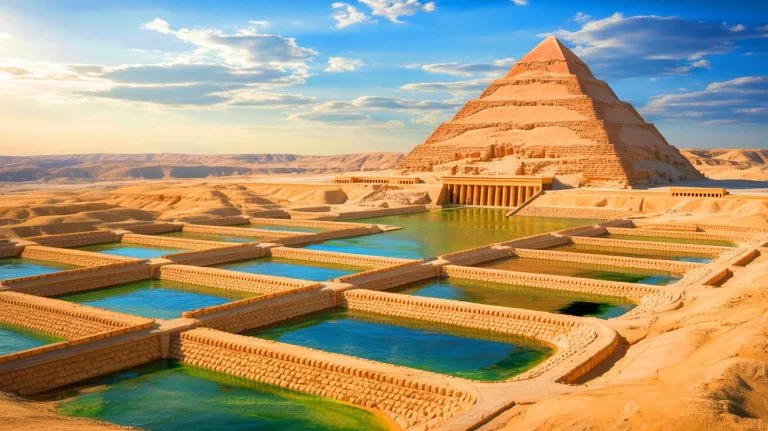| IN A NUTSHELL |
|
In the arid expanse of the Egyptian desert, a groundbreaking discovery is challenging traditional narratives about ancient engineering prowess. Deep beneath the sands surrounding the Pyramid of Djoser lies a sophisticated water management system that has puzzled and amazed researchers. This revelation highlights a forgotten chapter of human ingenuity, suggesting that ancient Egyptians employed advanced hydraulic techniques in their monumental construction projects. The implications of this finding extend beyond the technological realm and invite a reevaluation of historical perspectives on the architectural feats of the Old Kingdom builders.
Ingenious Stone Dam Capturing Desert Floodwaters
The enigmatic structure at Saqqara, known as Gisr el-Mudir, has long intrigued scholars with its grandeur and mystery. Spanning nearly 1,180 feet, its purpose has been debated for years. Recent research by Xavier Landreau and his team from the CEA Paleotechnic Institute offers a new perspective, suggesting that this massive stone enclosure was not merely ceremonial or defensive. Instead, it functioned as a dam, ingeniously capturing seasonal floodwaters from nearby valleys.
By meticulously analyzing the terrain, ancient watercourses, and erosion patterns, researchers reconstructed a watershed system capable of channeling water to the enclosure. This temporary reservoir, capable of holding up to 14 million cubic feet of water, supported large-scale construction activities. Seasonal floods would deposit nutrient-rich sediments in downstream basins, enhancing the site’s utility. The discovery redefines Saqqara’s historical significance, indicating that its location was chosen for hydrological advantages as much as religious or political reasons.
How Hydraulic Construction of Pyramids Worked
Adequate water storage was crucial, but it was merely the beginning. The real innovation lay in the depths of the Djoser complex, where a vast trench, once thought purely symbolic, revealed a network of interconnected basins and compartments. This “Deep Trench” served as an ancient water treatment system, with heavier sediments settling first and clearer water being transferred further.
This purified water powered a vertical lifting system beneath the pyramid. Two vertical shafts, connected by a 656-foot underground gallery, enabled a flotation device to lift stone blocks. The blocks, placed on a floating platform, were elevated through water pressure injected into the shafts. Once at the desired height, they could be moved onto the structure’s upper tiers. This system resembled a hydraulic elevator, utilizing water’s force to minimize mechanical effort, a testament to the Egyptians’ engineering acumen.
Sophisticated Technology Matching Pharaohs’ Ambitions
While the hydraulic construction hypothesis may seem audacious, it is grounded in concrete evidence from the site. The dam, basins, galleries, and shafts all form a cohesive hydraulic chain. Contrary to common belief, the Egyptians had already mastered various water-related techniques. Their expertise in creating irrigation canals, wooden gates, and agricultural dams highlights their advanced understanding of hydraulics.
This study suggests that such a system could have significantly reduced the need for massive external ramps, lowering labor demands and logistical challenges. The construction process would have gained efficiency, safety, and precision. The Pyramid of Djoser, often seen as a prototype, may represent the zenith of a developed technology that subsequent dynasties struggled to replicate. This finding challenges the conventional narrative of pyramid construction, blending ingenious engineering with environmental adaptation.
How Saqqara’s Hydraulic Remains Alter Our Historical Perspective
Traditionally, pyramids have been examined from symbolic or architectural viewpoints. The discovery of an integrated hydraulic system shifts this focus, revealing that the builders were not solely executing religious projects. They were also crafting sustainable technical ecosystems, adeptly adapting to their environment and available resources.
This multidisciplinary approach, combining archaeology, hydrology, and geotechnics, enriches our comprehension of the past. It unveils a sophisticated work organization, rigorous material management, and a nuanced exploitation of the territory. It is now conceivable that these monumental constructions were not merely the result of massive labor mobilization but also the outcome of underestimated technical genius. This new perspective prompts a reassessment of other ancient sites, searching for similar hidden hydraulic systems.
As we delve deeper into the ancient Egyptians’ engineering marvels, we are left to ponder: What other hidden technologies lie beneath the sands, waiting to redefine our understanding of history once more?
Did you like it? 4.7/5 (23)








Wow, I never knew the ancient Egyptians were such hydraulic geniuses! 🌊
Wow, this is amazing! How did they even come up with such advanced hydraulic systems? 🤯